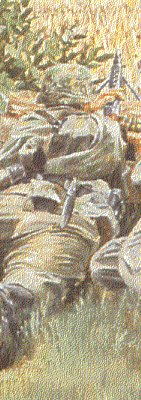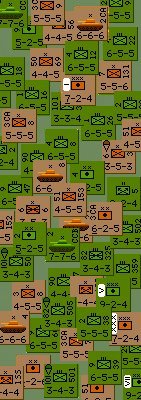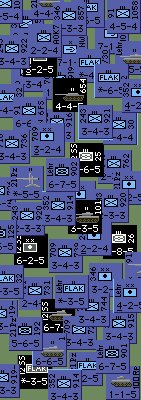
Deploying 12SS and Lehr
At Dawn on June 7, the German player gets some fearsome and absolutely essential reinforcements:
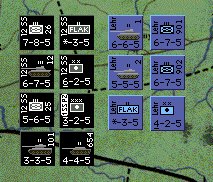 |
|
How should these vital units be deployed? Where should they enter the mapboard? How should they be utilized? What are the best options available and how should the German player decide?
These forces, while certainly powerful, have major responsibilities. Their job is to:
(i) reinforce Caen;
(ii) defend the backdoor entrance to Caen via Bourguebus (Area 5) or Evercy (Area 11);
(iii) threaten Merville (Area 7); and
(iv) support the German defence in the centre of the mapboard.
The ways in which the forces are deployed to achieve these objectives will vary from game to game, depending on what the Allied player does and how the dice roll. "Big Black" can begin in either Rouen or Chartres, while Lehr can start in Chartres or Le Mans.
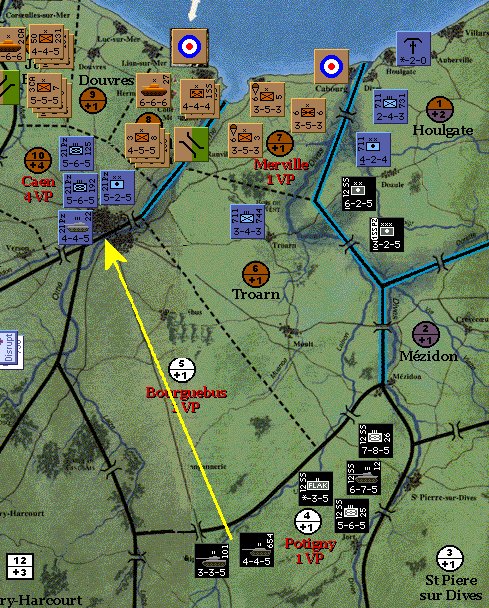 |
Conventional play brings the 12SS divisional artillery and the 1SS Pz Corps artillery into the battle at Rouen (Area A), where they can regroup into Houlgate (Area 1) on the night of June 7 and menace Allied forces in Merville thereafter. These artillery can usually generate several good bombardments between June 8 and 12, and they also threaten to support assaulting Panzers from the 12SS Division, coming out of Potigny (Area 4). The 12SS divisional artillery has the best guns in the Wehrmacht and they should be put to good use. The guns of the Corps artillery are much weaker, but they are a useful addition to any assaulting SS force. |
Repeated bombardments might weaken the Allied Merville defence to the point where the 12SS Panzer Division can assault, later in the game, with an Attack Factor of 10 or more at a well chosen moment when the weather turns overcast. If the Allied player tries to surround Caen by attacking through Troarn (Area 6) and, he hopes, eventually into Bourguebus, the German player can make him run the gauntlet, blasting away at spent units in Areas 6 and 7 from Houlgate. This threat, combined with the presence of the 12SS panzers in Potigny, is often sufficient to deter the Allied player from any such encirclement attempt.
If the weather changes to overcast on June 7, the German player should consider sending the 12SS divisional artillery, and possibly the 1SS pz Corps artillery as well, to Caumont (Area 23) from where they can refit and regroup to Balleroy (Area 22) fresh for the morning of June 8. This tactic, while it obviously weakens the threat against Merville, can shake up the Allied player's plans for the centre quite considerably. From Balleroy, the six-factor artillery might bombard a large stack of spent British units after they assault Bayeux (Area 20) or Tilly (Area 21), or they might sock it to the Americans after they contest Forêt de Cerisy (Area 28). Moving one or both SS artillery units to the centre in this way does let the Allied player feel more comfortable in Merville, but he cannot afford to get too comfortable because the 4-factor 711 Divisional artillery likely remains in Houlgate and the 3-factor 346 Divisional artillery also enters play at Rouen on June 8.
The six remaining SS units usually begin in Chartres (Area B), regrouping to Potigny during the night of June 7. One can also consider moving the 12SS FLAK unit to Potigny on June 7, refitting and regrouping to Troarn overnight. This way, the FLAK battalion is available to help counter air interdiction should the German player decide to send his main SS forces from Potigny in an assault on Merville at some point on June 8.
One or both of the 101 and 654 SS Panzer battalions often move into Caen to bolster its defences. Being armor, they absorb more Attrition Points than other unit types and God knows Caen usually suffers heavy bombardment. Moreover, since their Attack Factors are comparatively low and they cannot contribute to any Divisional Integrity Bonus, they are more useful for defensive as opposed to offensive purposes. If the German player feels lucky, or if the weather changes to overcast, or if the Allied player has a big early threat going against Caen, he might move one or both units from Chartres all the way into Caen on June 7. Otherwise, if the Allied player is not pressing too hard on the city, the 101 and 654 battalions might make the transit on June 8 from Potigny, or not at all.
The 12, 25 and 26 regiments are powerful units and the divisional FLAK battalion provides additional support. This division is a very strong threat and its greatest value is just that. The Allied player never knows when the weather might change and he must keep a wary eye on those SS regiments. The German player should think twice before expending the threat, because eastern Normandy will look a lot more vulnerable once these units are spent -- or worse, D1. More often than not, the best German tactic is to leave these units fresh, in a safe but menacing position such as Potigny. And if they assault, they had better do it after the Royal Navy has fired its guns. Attacking Merville or Troarn while the ETF is still fresh is almost guaranteed to bring a swift reprisal, reducing most of Big Black to D1 and effectively taking them out of the game from that point onward. However, the Merville prize is nothing to be sneezed at and if a good chance to reclaim it arises, the German should grab the opportunity without much hesitation. Merville is a Victory Point Area, after all. Moreover, regaining control of the Area may mean claiming the Advantage and, possibly, a favourable Sunset DRM. There is the added benefit that it shortens the German line. If the German player can take Merville, grab the Advantage and refit his forces to defend the Area on June 8 he will be in a very fine position as June 9 dawns.
As with the 12SS and 1SS artillery, the German player should think seriously about reinforcing the middle area with Panzers if the weather changes to overcast. One good Panzer regiment can be easily afforded for this assignment without greatly weakening the assault threat against Merville, though if you're going to do this you should probably hold back the FLAK unit with the other 12SS forces rather than pushing it forward to provide air cover. The Allied player will surely feel a lot more insecure with a 6 or 7 Attack Factor Panzer regiment hunkered down in, say, Forêt de Cerisy.
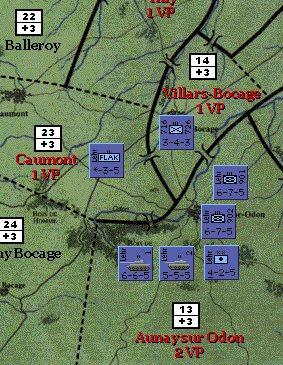 |
Lehr typically starts in Le Mans (Area C). The standard tactic, if it turns out to be possible, is to move the entire division from Le Mans to Laval (Area D) late in the day on June 7 and regroup to Aunay sur Odon (Area 13) overnight. This puts these powerful units in excellent position to help defend the middle, and to pose a threat to weakly garrisoned Allied Areas if the weather turns overcast. Some players advocate moving the Lehr FLAK unit directly to Aunay sur Odon on June 7, risking air interdiction. The FLAK can then be refitted and regrouped to Caumont (Area 23) at the end of the day, standing ready to counter Allied air interdiction should it be necessary to move Lehr units toward Forêt de Cerisy, Balleroy (Area 22) or St. Lo (Area 27) while the weather is clear on June 8. The move of Lehr from Area C to D on June 7 must wait until the British have committed their fresh forces. Disaster might come otherwise, if Lehr lies spent in D while the British begin attacking Tilly (Area 21), Villars-Bocage (Area 14) or Aunay sur Odon (via Verson and Evercy).
|
Of course, it's not always possible to hold back Lehr and conserve supply as just described. In some games the Allies threaten to break through the German lines at Bayeux, Tilly and Villars-Bocage on June 7 and when this happens, it's usually necessary to bring in at least part of Lehr to help with the defence. The defensive strength of Lehr's 901 and 902 Panzer Grenadier regiments should not be overlooked. They add 7 to the Defence Factor when fresh and 4 when spent. These units are the best defensive weapons in the Axis Order of Battle. It's often a good idea to lodge them in two key Areas, such as Tilly and Villars-Bocage, and keep them there throughout the game. The two Panzer battalions, Lehr 1 and 2, plus the FLAK and divisional artillery make a good offensive threat combination and should be positioned toward that end if at all possible. The fourteen units arriving on June 7 carry the hopes and prayers of the Wehrmacht with them. Treasuring and husbanding them are keys to victory for the German side.
